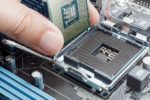What Is VRM on Motherboard and How Does It Help?

Building a PC is relatively easy, but we seldom notice the value of electrical engineering put into computer components.
One of the most important power conversion components of a computer is its motherboard’s VRM.
What is VRM on motherboard integrated circuits, and what does it have to do with power conversion?
What Is VRM on Motherboard?
Electrical power conversion is fundamental to modern living.
It is the process of changing electricity from one form to another using a power converter.
One of the most basic functions of a power converter is to change alternating current (AC) into direct current (DC).
Whether it is AC to DC or DC to DC, household electronics will always require the help of power converters to get DC.
VRM stands for Voltage Regulator Module. Simply put, a VRM regulates the electricity supplied to a computer processor (CPU) or a graphics processing unit (GPU).
It is responsible for streamlining the voltage delivered to these electronic components.
While a modern GPU typically has its VRMs embedded onto the graphics card itself, a CPU will have its supplemental VRMs on the printed circuit board (PCB).
In this discussion, we will be focusing on how a VRM regulates power interactions between a PCB and a CPU.
ALSO READ: Are ASRock Motherboards Good?
Specified Operating Voltage
A computer’s power supply unit (PSU) delivers 12 volts to the PCB for use in the CPU.
However, the PCB must drop the voltage to a more usable output for the CPU, called core voltage or vCore.
An average computer processor operates at a specified voltage identification definition (VID), usually between 1.1 volts and 1.3 volts.
For those trying to learn how to overclock a PC, keep in mind that a long-term average vCore of more than 1.3 volts may threaten the PCB’s silicon components.
Nevertheless, short-term application of higher voltages can improve stability during extreme overclocks.
VRM controls allow a quarter volt increase or decrease in vCore range for overclocking and underclocking, respectively.
The process by which a VRM converts the PSU voltage to vCore is called power phasing.
Power Phasing
Power phasing streamlines the voltage supply and reduces the chances of a vCore fluctuation, also called vDroop.
A vDroop can come in the form of a voltage drop or a power surge, and it can cause computer crashes and errors, such as the blue screen of death (BSOD).
By sending the vCore through more than a single power phase, the risk of vDroop diminishes, and overall stability improves.
VRMs and power phasing are by no means specific to computer processors and graphics cards.
You can also find them on electronic devices with microprocessors. Examples include radios, televisions, other household appliances, and vehicles.
Components of VRM
Some might think that the VRM is an independent, self-contained component on a PCB.
In reality, a VRM is a collective name for a combination of MOSFETs, Driver ICs, controllers, capacitors, and chokes, all working together to phase power.
A MOSFET, or a metal-oxide-semiconductor field-effect transistor, is responsible for amplifying and switching signals and assisting in voltage identification.
To do its job with precision, a MOSFET communicates with the CPU through a pulse-width modulation (PWM) controller.
A driver IC is an integrated circuit chip functioning as a motor controlling device. Modern MOSFET chips integrate the driver IC.
Capacitors store electricity and release it as instructed by the controller, thereby regulating and filtering periodic pulses to correct voltage ripple and spikes.
A capacitor stores electricity in an electric field, and it opposes voltage change.
Output capacitors ensure that the VRM supplies a constant voltage to the CPU.
The inductors, also called chokes, store electricity in a magnetic field and oppose current change.
How Do Motherboard VRMs Work?
A VRM circuit typically works like a buck converter or a step-down converter.
A buck converter is a DC-to-DC converter that steps down the voltage from a supply input to an output load.
While VRMs on PC motherboards typically work using multiple power phases, it is easier to understand how they work by looking at a complete single-phase cycle.
If you enjoy this topic, you might also be interested in our write-up on the different motherboard parts and how they function.
Single Phase
In a single-phase VRM, there are two MOSFETs: a low-side MOSFET and a high-side MOSFET, both serving as switches.
You will find the choke or inductor before the CPU.
As the high-side switch is closed, the voltage right after it and before the choke becomes 12 volts.
However, the voltage right after the choke does not instantaneously shift to 12 volts.
Instead, as the 12-volt current goes through the choke, it tries to resist the change in voltage by creating a magnetic field.
This magnetic field generates a voltage drop on the output side, transferring a current with much lower voltage to the CPU.
When the high-side switch is opened, the voltage before the choke becomes zero, but the choke still holds a magnetic field.
As the magnetic field discharges and the high-side switch remains open, a surge builds up after the choke, closing the low-side switch.
This switching enables the current to flow through the low-side switch and recirculate through the circuit.
The objective of the circuit is to deliver a constant specific voltage, around 1.2 volts.
To achieve this, the circuit automatically opens the high-side switch when the voltage right after the choke reaches 1.2 volts.
This entire cycle keeps recurring and is called pulse-width modulation.
The instructions for switching the high-side and low-side MOSFETs come from a PWM controller and through a Driver IC or a Doubler.
Multiple Phases
So, what is VRM on motherboards exactly? In modern motherboards, VRMs have multiple phases.
A multi-phase VRM has several single-phase VRMs working in parallel circuits.
Each of the single-phase circuits within the whole system only handles a portion of the total current required by the CPU.
For a multi-phase VRM to deliver the same operational voltage, only a single phase has the high-side switch closed at any given time.
This offset ensures that while one phase charges, all the chokes of the rest are discharging.
As a phase circuit starts dropping voltage, the next one immediately takes over.
How Do Motherboard VRMs Improve PC Performance?
The goal of having a VRM on a motherboard is to provide stable and reliable electricity for the CPU.
It improves PC round-the-clock performance simply by ensuring that the CPU gets only the power that it needs.
CPUs are very delicate components that can only run smoothly on stable and reliable power.
Multi-phase VRMs deliver a much more stable average voltage to the CPU.
With more phases, smaller amplitudes result in tighter voltage tolerance. And with tighter tolerances, output voltages are much more stable.
If a VRM system has more phases, a smaller voltage goes through each of the phases.
Since heat generation becomes minimal with lower voltages, the motherboard components become less stressed, run smoother, and last longer.
A simple, multi-phase VRM can deliver good performance to a mid-range CPU at stock speeds, but pushing the limits through overclocking might require better VRMs.
Choosing the Right Motherboard
Anyone looking to overclock a motherboard should look for VRMs having the best components.
Cheap components subjected to overclocking can result in unexpected crashes or shutdowns.
When choosing a motherboard for overclocking, the most important VRM components to check out are the chokes and capacitors.
Many motherboards offer leak-resistant capacitors typically labeled as “Solid Capacitors,” “Japan-made Capacitors,” “Hi-C Caps,” “Military-Grade Components,” or “Dark Capacitors.”
High-end chokes or inductors will have the labels “Premium Alloy Chokes” or “Super-ferrite Chokes” (SFCs).
Additionally, the best VRMs will have top-of-the-line finned heatsinks covering all or some of the MOSFETs.
Keep in mind that having a power-intensive CPU, such as a Threadripper, will require a motherboard with an excellent-quality VRM.
Quality of Phases
As discussed, the quality of the VRM components will directly affect the quality of the phases.
While a multi-phase VRM means having a more stable voltage output, more phases do not necessarily imply having a better overall VRM.
A six-phase VRM with high-quality components could perform better than a substandard 12-phase.
When comparing products, always check the components of a motherboard’s VRM, especially when you plan to overclock.
Doublers
Most motherboard VRMs come in either 4, 6, or 8 phases.
Some rare models have up to 10 real phases, but the vast majority have VRMs with only four or eight power stages.
Motherboard brands may offer up their products with 12, 16, or more phases using phase doublers.
A phase doubler generates two interleaved signals using the original phase count, doubling the number of phases.
Doublers help by reducing the load current on any given phase and extending the lifespan of all the components.
However, having doublers means that the VRM now has double the amount of integrated circuits, resulting in a much more expensive motherboard.
Doublers are typically the common solution for boards advertising an eight-phase or 16-phase VRM.
Deceptive VRMs
Be careful when choosing a motherboard and considering its VRM components.
Some products have ads and labels indicating double the actual number of real phases present in their VRMs.
The common practice for manufacturers is to double the number of actual phases, even if their VRMs are using doublers.
Furthermore, there can be less desirable implementations from deceptive models.
One common scheme sets two separate circuits to receive a single PWM signal, resulting only in a single phase.
A manufacturer may or may not call it two phases, but it doesn’t really result in better voltage thresholds.
RELATED: Red Light on Motherboard (Guide)
Conclusion
Even after understanding what VRMs are, it can be challenging to look for a motherboard with a good-quality VRM.
Furthermore, product cost and marketing materials can be very unreliable determinants.
When checking VRMs on a particular board, it is always best to do your research.
You can get reliable expert reviews and advice from enthusiasts who go online every day to scrutinize these products.
We also feature some of the best motherboards for top-tier Intel Core and Ryzen processors as well as for gaming enthusiasts.





